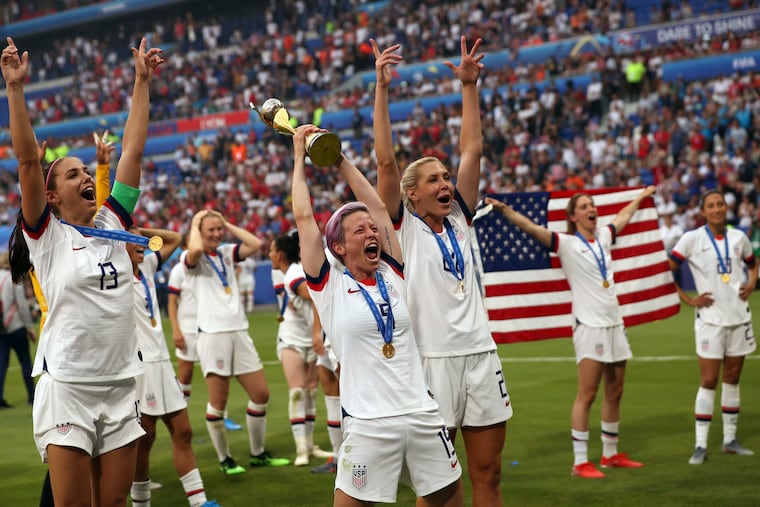A stadium of soccer fans chanting ‘Equal pay!’ feels like a turning point. Will it be?
Even if these world-class athletes succeed in their still-uncertain quest for pay equity, what does it mean for the women who are teachers, police officers, or servers?

As the president of the world soccer federation prepared to hand out medals to the Women’s World Cup champions Sunday, a chant broke out from the fans in the French stadium who’d just watched their team from the United States cement its place in the history books: “E-qual pay! E-qual pay!"
It was a moment — one that advocates for women in the workplace saw as a turning point in the public conversation surrounding the gender wage gap.
But even if these world-class athletes succeed in their still-uncertain quest for pay equity, what does it mean for the women who are teachers, police officers, or servers, the nonmillionaires who don’t have adoring fans advocating on their behalf?
“Everyone in that stadium saw some reason to take up that cause, and I don’t think they were just speaking for the athletes,” said Terri Boyer, director of the Anne Welsh McNulty Institute for Women’s Leadership at Villanova University. “They weren’t saying ‘equal pay for these women.’ They were saying ‘equal pay.’ Which means the public is interested in this.”
The win in Lyon and the ensuing chant was a stark reminder of the lawsuit the U.S. team has filed against the U.S. Soccer Federation. The team is alleging gender discrimination and demanding pay equal to that of the men’s national team, claiming in its lawsuit that if each team played and won 20 exhibition games in a year, female players could earn a maximum of $99,000 while the men could earn up to $263,000. The suit is expected to go to mediation now that the Cup is over.
According to ESPN, FIFA will award $30 million in prize money for the Women’s World Cup, while the men received about $400 million last year. The president of FIFA has said he wants to double the women’s prize money by 2023, though the organization is also expected to increase the men’s award to $440 million in 2022.
Boyer said it makes sense that a highly successful sports team like the U.S. was able to bring the conversation about equal pay to the forefront. The pay discrepancy in the sport is an easy way for people to digest the gender pay gap — it’s a clear apples-to-apples comparison, she said.
Within minutes of the 2-0 win over the Netherlands, the U.S. women’s players association released a statement: “At this moment of tremendous pride for America, the sad equation remains all too clear, and Americans won’t stand for it anymore." After the game, star player Megan Rapinoe said it’s time for the conversation about equal pay to stop being theoretical.
“Everyone is kind of asking what’s next and what we want to come of all of this,” she said. “It’s to stop having the conversation about equal pay and are we worth it and should we, and the investment piece. What are we going to do about it?”
Added forward Tobin Heath: “In a lot of ways, this team has been, I guess you could call it, single destiny with this fight for equal pay. I think it’s our responsibility, and it’s something that we love to do.”
Federal labor data show that women, on average, make about 82 cents for every dollar their male counterparts make, a rate that’s been largely unchanged for the last decade. Some research has found that when studied over decades, women actually make about half what men do.
There have been plenty of high-profile examples of wage differences for men and women who seem to be performing the same jobs, but Boyer said it feels like the issue is finally having its moment, driven largely by younger generations of women — who say wage equity is one of their greatest workplace concerns — entering the workforce. At the same time, the gender pay gap is now narrower among younger adults compared with the rest of the workforce.
>> READ MORE: Six women recall when they found out they were getting paid less than their male coworkers
Experts on the gender wage gap say advocates for women in the workplace must leverage the public fervor to push lawmakers to adopt new policies aimed at closing the gap (companies’ attempts to fix their own wage gaps often fail).
For example, Philadelphia in 2017 passed a bill making the city one of the first jurisdictions in the country to ban employers from asking job candidates about wage history. The idea is that inequity can snowball when pay continues to be based on an employee’s former salary. The fate of the law is uncertain, as the U.S. Court of Appeals for the Third Circuit is currently weighing whether the ban violates the free speech rights of employers.
On the state level, Pennsylvania lawmakers haven’t updated the state’s Equal Pay Act since the 1960s, but New Jersey leaders last year passed some of the country’s strongest wage equity legislation. Federally, the U.S. House passed the Paycheck Fairness Act, which would make it harder for employers to justify gender-based pay disparities.
For Boyer, the next step is addressing the complexities of society-wide gender bias (like family care policies in workplaces), and developing more “comprehensive” public policies to mitigate it.
Among other policies touted by women’s advocates are rules requiring companies to disclose salary information broken down by gender and race, better accommodations for pregnant women, and higher pay in industries dominated by women.
“This is a good moment to leverage,” Boyer said. “What you’re going to see happening is that shift that’s coming, not just from policymakers and advocates who have been talking about this for decades, but from people themselves.”